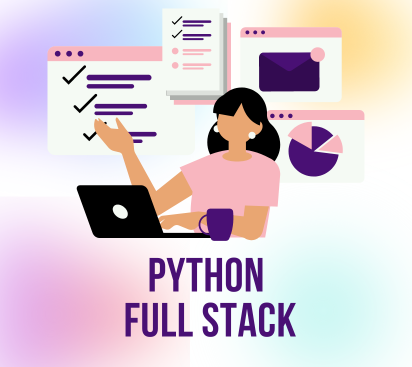

Course Syllabus
A Python Full Stack course provides comprehensive training in developing web applications using Python for both front-end and back-end development. You'll learn to build dynamic web applications with Python frameworks like Django or Flask for the server-side, and integrate front-end technologies such as HTML, CSS, and JavaScript. The course also covers database management with SQL databases, RESTful API development, and deployment practices. By the end, you'll be adept at creating, managing, and deploying complete web applications.
Front End Syallabus
- Introduction to HTML
- History of HTML
- Components of HTML
- Structure of HTML
- Body section
- Categories of Tag in Body Section
- How to display images
- Creating List
- Ordered List
- Unordered List
- Definition List
- How to work with background?
- How to print special characters?
- Creating Tables in HTML
- Attributes of Table
- Generating Irregular Tables
- How to work with forms?
- How to work input controls?
- Using <select> Tag
- Generating Drop Down List
- Generating Scrollable List
- How to work text area?
- Introduction to HTML 5
- Improvements Given by HTML 5
- Web Forms 2.0
- New Input Elements
- New Form Attributes
- DataList Tag
- Playing Audio
- Controlling Audio
- Playing Video
- Introduction to CSS
- Advantages of CSS
- Versions of CSS
- Versions of CSS
- Types of CSS
- CSS Selectors
- Project
- Inheritance in CSS
- CSS Units
- Absolute v/s Relative Units
- Styling Background using CSS
- Handling Font in CSS
- Various Font Properties
- What are Google Fonts
- How to use Google Fonts
- Project
- Handling Text in CSS
- Various Text Properties
- Removing Underline from Links
- Handling Link in CSS
- Pseudo-Classes
- Making Links Look Like Button
- Styling Lists in CSS
- Making Nav Bar Using List
- Styling Tables in CSS
- Styling Table Border
- Creating Zebra Striped Tables
- Making Tables Responsive
- Project
- The <div> and <span> Tags
- The Difference
- Introduction to semantic HTML
- Popular Semantic HTML Tags
- The CSS Box Model
- Border, Padding and Margin
- Handling Overflow
- Setting Element Pos using Float
- The Visibility Property
- The Display Property
- Positioning in CSS
- Various Types of Positioning in CSS
- Other properties used with Positioning
- Styling form in CSS
- Attribute Selectors
- Styling Controls
- What is JavaScript?
- Who runs our JavaScript code?
- Relationship with HTML and CSS
- What JavaScript can do in Browser?
- What JavaScript can't do?
- Java v/s JavaScript
- History of JavaScript
- JavaScript Embedding
- Writing to the document
- Using Browser Console
- Comments in JavaScript
- Declaring variables in JavaScript
- Data Types
- Primitive Data Types and Non-Primitive Data Types
- Difference between null and undefined
- Var v/s let
- Types of Dialog Box
- Accepting Numeric input through Dialog box
- Using Template String
- Types of Operators
- Type Conversion & Type Coercion
- Standard rules of Number Conversion
- Controlling Decimal Points
- If
- If else
- If else if else
- Nested if
- Ternary Operator
- Switch
- While loop
- Do while loop
- For loop
- For/of loop
- For/in loop
- Array Definition
- Creating Array
- Using Loop with array
- Array with mixed type
- Creating Array using Constructor
- Array Methods
- What is Function?
- Function calling
- Calling Function from link
- Variable scope
- Returning values
- Calling function via Button
- Anonymous Functions
- Some important built-in functions
- Objects in JavaScript
- Creating Objects
- Adding properties, changing properties, and Deleting properties
- Adding methods
- Nested Objects
- Creating object using object literal
- The toString() method
- Overriding toString()
- Object equality in JavaScript
- What is JSON?
- The 'this' keyword and using of 'this' keyword
- The Arrow function
- Restriction on Arrow function
- Callback function
- Anonymous function as callbacks
- Why we need callback?
- The Date object
- The String object
- The Math object
- DOM introduction
- What is DOM?
- What can be done with DOM?
- DOM selection methods
- Setting/Getting Text Content
- Changing CSS
- Adding & Removing classes
- Traversing the DOM
- DOM properties
- DOM properties drawback
- Modern DOM properties
- Creating new element
- append() & preprend()
- Event Introduction
- Event categories
- Ways of handling events
- Using function for event handling
- Cancelling the default behaviour
- Using DOM event handler
- Working with MouseEvents
- Working with KeyBoard Events
- Determining the key Pressed
- Using DOM level 2 event handler
- The event object
- Event Bubbling
- Event delegation
- Accessing form object through JavaScript
- Accessing Form data
- The submit event & how to handle submit event
- Other form events
- Creating A ToDo List App
- Apply All The Concepts Learnt Till Now
Python Syallabus
- Necessity of Programming.
- What is Python?
- Why And Who Created It?
- What Python Can Do ?
- Why Should I learn Python?
- Important Features
- Version History
- Different Python Implementations.
- Downloading And Installing Python.
- Testing Python Installation.
- What is Python Shell?
- Using Python Shell.
- What Python Can Do ?
- Writing Python Script Using Notepad.
- Running Python Script.
- How To View The Bytecode File?
- Introduction To Predefined Functions And Mudules.
- How print() function work?
- How To Remove Newline From print()?
- Introduction To IDLE.
- Types Of Errors In Python.
- Rules For Identifiers.
- Python Reserved Words
- Basic Data Types In Python
- Some Very Important Points To Remember.
- Numeric Types.
- Converting Between Int Types.
- The Float Type.
- The Complex Type.
- The bool Type.
- The str Type.
- Concatenating Strings.
- The Slice Operator In Strings.
- Three Important String Function.
- Type conversion.
- How Variables In Python Are Different than Other Languages?
- Immutable And Mutable.
- Python's Memory Mangement.
- The id() and is() Function.
- How to write Comments in Python?
- How to create constants in Python?
- How to Print a variables value using print()?
- Types of Operators.
- Arithmetic operators.
- Special point about + and *
- Difference between / and //
- Relational Operators.
- Relational Operators With Strings.
- Chaining of Relational Operators.
- Special Behavior Of == and !=
- Logical Operators.
- How Logical Operators Work With Boolean Types?
- How Logical Operators Work With Non-Boolean Types?
- Assignment Operators.
- Various Types of Assignment Operators.
- Compound Operators.
- Identity Operators.
- Membership Operators.
- Precedence And Associativity.
- Using the Input() Function.
- Using the math Module.
- Different ways of importing a module
- Accepting multiple values in single-line.
- Using the eval() Function
- Using Command-line Arguments.
- Using format specifiers.
- Using the function format().
- The if Statement.
- Concept of Indentation.
- The if-else Statement.
- The if-elif-else Statement.
- What about ternary operator?
- Types of loop supported by Python.
- The while loop.
- The while-else loop.
- The break,continue and pass Statement.
- The for loopIntroduction to Pycharm
- Introduction to Pycharm IDE
- Downloading and Installing
- Developing Fist Application In Pycharm.
- What is a Function?
- Function v/s Method.
- Steps Required For Developing user Defined Function.
- Calling a Function
- Returning value form Function
- Arguments v/s Parameters
- Types Of Arguments
- Variable Scope.
- Global Scope.
- Variable Scope.
- Argument Passing.
- Anonymous Functions or Lambda Function
- The map() Function
- The filter () Function
- Using map() and filter() Lambda Expressions.
- What is a List?
- Creating a List.
- Accessing The List Elements
- Adding new Data In the List
- The Slice Operator With List
- Modifying A List
- Deletion In A List
- Appending / Prepending Item In a List
- Multiplying A List
- Membership Operators On List
- Built In Functions For List
- Method Of List
- List Comprehension
- What Is A Tuple?
- Differences With List
- Benefits Of Tuple
- Creating Tuple
- Packing / Unpacking A Tuple
- Accessing A Tuple
- Changing the Tuple
- Deleting the Tuple
- Functions Used With Tuple
- Method Used With Tuple
- Operations Allowed On Tuple
- What is A String?
- Creating A String
- Different Ways Of Accessing Strings
- Operators Which Work On Strings
- Built In String Functions
- Printing String using f-string
- Modifying Strings
- String Methods
- What is A Dictionary?
- What is key- value pair?
- Creating A Dictionary
- Important Characteristics Of A Dictionary
- Different Ways To Access A Dictionary
- Updating Elements In Dictionary
- Removing Elements From Dictionary
- Functions Used In Dictionary
- Dictionary Methods
- Dictionary Comprehension
- Restrictions On Keys
- Introduction To Exception handling
- Exception Handling Keywords
- Exception Handling Syntax
- Handling Multiple Exceptions
- Handling All Exceptions
- Using Exception Object
- Getting Details Of Exception
- Raising An Exception
- Using finally Block
- Creating user Defined Exceptions
- What is Operator Overloading
- How To Perform Operator Overloading
- List of Operator Which Can Be Overloaded
- Reverse Arithmetic Operators
- What is Data And Database?
- What is DBMS?
- What is SQL?
- How to configure our system for database programming.
- Introduction To SQLite
- Using Exception Object
- Steps Needed For Connecting To SQLite From Python
- Exploring Connection And Cursor Objects
- Executing the SQL Queries
- Different Ways of Fetching the Data
- Executing INSERT Command
- Executing Dynamic Queries
- Concept of Bind Variables
- Executing Update Command
- Executing Delete Command
- What is File Handling?
- What is the need of File Handling?
- Examples Where Files Are Used?
- Python's Way of handling Files
- Files Opening Modes
- Writing In A File
- Different Ways For Reading From File
- The seek() Method
- Appending in a File
- Using with statement
- What is module?
- Different ways of Importing Module
- The concept of the variable__name__
Django Syllabus
- What is Python?
- Why To Use Python For Web Development?
- Pre-requisites For This Course
- What is Django?
- Front End V/s Back End
- What is Full Stack Development?
- History Of Django
- Quick Recap of Django Introduction
- Architecture Of Django
- Recap Of MVC
- Django's MVT
- Setting Up The System
- Creating Virtual Environment
- Installing And Testing Django
- Starting A Django Project
- Django Project V/s Django App
- Creating A Django Project
- Understanding The File Structure
- Running The Django Project
- A Little Bit About Migrations
- Creating Django Environment In VS
- Creating Django Project In VS
- Running The Django Project In VS
- What is An App?
- Creating An App
- Default Components Of An App
- Activating The App
- Understanding A View
- Creating A View
- Configuring The URL
- Running The App
- Creating Multiple Apps In a Single Project
- Steps Required
- Generating Calendar For Browser
- Configuring Multiple URLs
- Solving The Name Conflicts
- Running Multiple Apps
- Drawbacks In Configuring Site Level urls.py
- Creating App Level urls.py
- Configuration The URL
- Running The App
- Steps Needed For Templating
- Template Directory Structure
- Activating The App
- Creating The Templates Directory
- Creating The HTML File
- Creating The View
- Configuring The View In Url
- Creating Separate Template Folder
- Passing Data To Templates
- Concept Of Template Variable
- Template Filters In DTL
- Tags In DTL
- The Dot LookUp Mechanism
- The for Tag
- Variables Of for Tag
- Loading Static Files
- How To Use Static Files
- Template Inheritance
- Static Files In Template Inheritance
- Merging App Level Static Files With Project Level Static File
- Creating Hyperlinks In Django
- Using The Include Tag
- Database Programming In Django
- Using Python's Database Programming Model In Django
- Drawbacks Of Python’s Database Programming Model
- Introduction To Django Models
- Introduction To ORM
- Using Django Interactive Shell
- Exploring The Request object
- Accessing HTTP Headers
- Getting User Input
- Handling HTML Forms
- Using Django Form Library
- Configuring Form Options
- Getting Form Data
- Validating Data
- Getting Cleaned Data
- CSRF Protection
- Building A ContactUs App
- Redirecting User To New Page
- Applying Validation
- Using Keyword Arguments For Validations
- Using Methods For Validation
- Using Validators
- Using Custom Validators
- Customizing Error Messages
- Styling Error Messages
- Adding More Styles Using CSS
- Adding Form Data To The Database
- Using Models In View
- Introduction To Model Forms
- Benefits Of Model Form
- Creating And Using A Model Form
- Introduction To Session Tracking
- Why Session Tracking Is Important?
- How Django Supports In Session Tracking
- What Are Cookies?
- Using Cookies
- Drawbacks Of Cookies
- Introductions Session
- Understanding Django Session Framework
- Django's Default Set Up For Sessions
- Testing Cookies
- Accessing Session Object
- Operating On Session Data
- Where Is Session Data Stored?
- Changing Default Setting For Session
- Developing Session Based Registration/Login System
| Python Full Stack Introduction | Preview |
| Python Lecture 1 | Preview |
| Python Lecture 2 | Preview |
| Python Lecture 3 | Preview |
| Python Lecture 4 | Preview |
| Python Lecture 5 | Preview |
From Basics to Advanced Python Full Stack Development
- Full Stack Mastery: Learn Python full stack development, covering both frontend and backend technologies from basics to advanced.
- Zero to Hero: Evolve from a beginner to a proficient full stack developer with Python technologies.
- Comprehensive Coverage: Gain expertise in building full stack applications using Python frameworks, from frontend technologies like HTML, CSS, and JavaScript to backend development with Django or Flask and database management.
Live Lectures
- 100+ Hours: Engage in live, interactive sessions with industry experts specializing in Python full stack development.
- Hands-on Practice: Apply Python full stack concepts during live coding sessions and work on real-world projects.
- Practice Sessions: Participate in dedicated practice sessions to enhance your skills in both frontend and backend development with Python.
Doubt Solving
- Unlimited Doubt Clearing Sessions: Get all your questions resolved with support from experienced instructors.
Test Series and Assignments
- Topic-Wise Test Series: Assess your understanding with tests after each major topic in Python full stack development.
- Assignments: Apply your learning through practical assignments, including building and deploying full stack applications using Python.
Lecture Notes
- Detailed Notes: Access comprehensive notes for every lecture, covering all aspects of Python full stack development.
Projects
- Real-World Projects: Work on live projects to build and deploy full stack applications using Python technologies.
- API Development: Learn to create and manage RESTful APIs using Django or Flask for your frontend applications.
- Integration and Best Practices: Understand how to integrate frontend and backend components effectively and apply best practices in full stack development.
Certifications
- Dual Certification: Receive two certificates upon successful completion of the course and projects.
- Python Full Stack Development Completion Certificate: Earn a certificate for mastering full stack development with Python technologies.
- Project Completion Certificate: Get certified for successfully completing your Python full stack development projects.
Laptop / Computer Spefiications
- System With Minimum I3 Processor Or Better
- At Least 4 Gb Of Ram
Python Interpreter
Integrated Development Environment (IDE) or Text Editors
- Download PyCharm
- Download Visual Studio Code
- Install Jupyter via Anaconda
- Download Sublime Text
- Download Atom
Package Management
Version Control
Databases
Libraries and Frameworks
- NumPy Documentation
- Pandas Installation
- Matplotlib Installation
- Django Installation
- Flask Installation
- Requests Installation
- BeautifulSoup4 Installation
- Scrapy Installation
- Pytest Installation
Optional Tools
Documentation Tools
Ready to kick-start your career?
Join Us Now Join Us Now



